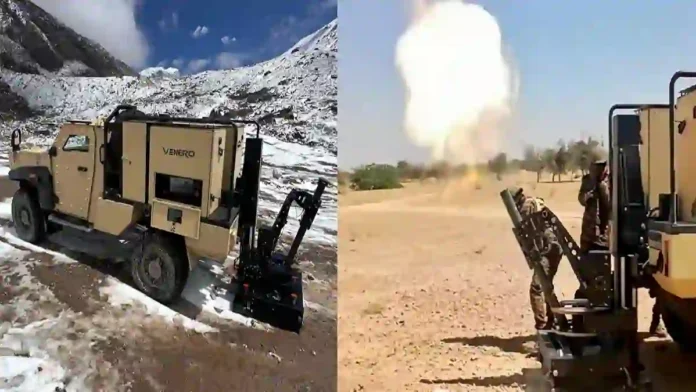The Indian Army is preparing for a significant boost in its indirect firepower by considering the procurement of up to 3,000 Vehicle-Mounted Infantry Mortar Systems (VMIMS). This follows the successful induction of 50 such systems featuring the NTGS Alakran-L 81mm mortar, which were delivered between 2023 and early 2024 under a fast-track acquisition process.
The first batch of systems was deployed with the Trishakti Corps in Sikkim in March 2025, where they are currently supporting operations along the Line of Actual Control with China. These units proved their adaptability to the extreme conditions of the Himalayas, offering the Army a new rapid-response firepower option for difficult terrain.
Read- The Undoing of Jinnah’s Pakistan
Spanish defence firm New Technologies Global Systems (NTGS), the developer of the Alakran system, has already established a local manufacturing base in India since 2023. According to NTGS executives, production of any future systems will occur within India to meet the Army’s scale requirements and localisation goals.
The current in-service variant of the VMIMS is built by integrating the Alakran-L automated 81mm mortar with Mahindra Defence Systems’ Armado 4×4 Armoured Light Specialist Vehicle (ALSV). Over 1,500 ALSVs are already in Army service, making the pairing an efficient solution in terms of logistics and fleet commonality.
The Alakran-L is an automated 81mm mortar system designed by Milanion NTGS and integrated with India’s Mahindra Defence 4×4 Armoured Light Specialist Vehicle (ALSV), known as the Armado. This Vehicle Mounted Infantry Mortar System (VMIMS) is characterised by its rapid deployment, high mobility, and precision, enabling quick setup and firing for “shoot and scoot” operations.
The digital fire control system, along with GIS technology, provides accurate and precise strikes, making it a key component of India’s indigenous defence modernization efforts under the Make in India initiative.
The Alakran mortar system offers survivability advantages. During operations, the mortar is deployed from the rear cargo bed onto a baseplate using an electro-mechanical mechanism, allowing stable firing even from rocky or paved ground. The vehicle can be ready to fire within 35 seconds of halting and can reposition within 25 seconds of firing its last round, making it well-suited for shoot-and-scoot tactics to evade counter-battery fire.
Read- How India Could Benefit From Europe’s 6th-Gen Fighter Jet Programs For Future Air Superiority
Read- India Preparing To Conduct Crucial Test New-Generation Long-Range Subsonic Cruise Missile
Operational data highlights solid firepower performance. The system has a maximum range of 7.2 km with high-explosive rounds, and can fire twelve rounds in the initial minute before transitioning to a sustained rate of four rounds per minute. Each vehicle comes equipped with 72 rounds onboard. A digital fire control display enables firing solutions, ballistic calculations and crew operation from inside or outside the vehicle. Integration with battle management and geo-information systems further enhances situational awareness and networking.
Field evaluations have proven the VMIMS’ reliability in both high-altitude and desert conditions, underscoring its utility across India’s diverse terrain. This high-angle fire support is particularly valuable in Himalayan deployments, where conventional artillery often faces limitations.
Globally, the Alakran system has also been adopted by Saudi Arabia, French special forces and Ukraine, where it has seen active combat. It is offered in both 81mm and 120mm variants, the latter providing extended range and heavier firepower. The system has also been tested with multiple light tactical vehicles, including the Polaris MZRZ 6×6 by the US Marine Corps.
However, given the scale of India’s planned procurement, the follow-on order may involve a competitive bidding process. Indian defence manufacturers such as Kalyani Strategic Systems, Larsen & Toubro and Tata Advanced Systems are likely to be contenders, particularly if the Ministry of Defence seeks wider domestic participation under the Make in India framework.
A formal timeline for the acquisition process has not yet been declared, but the allocation of budgetary resources indicates that procurement may move forward steadily over the next few years. Depending on whether India continues its partnership with NTGS and Mahindra Defence or opens the program to competition, the final configuration of the system may also undergo some adaptations to meet Army requirements.
IDN (With Agency Inputs)
Agencies




